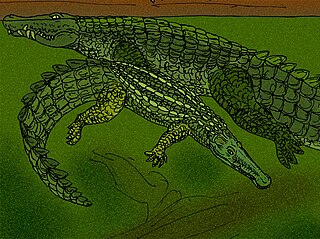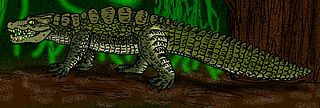 W
WBaru is an extinct genus of Australian mekosuchine crocodilian. It was semi-aquatic, around 4 m (13 ft) in length. Being semi-aquatic its habitat was around fresh pools of water in wet forests, ambushing their prey, much like modern species. The word Baru is Aboriginal and means "crocodile's ancestor".
 W
WCrocodiles or true crocodiles are large semiaquatic reptiles that live throughout the tropics in Africa, Asia, the Americas and Australia. Crocodylinae, all of whose members are considered true crocodiles, is classified as a biological subfamily. A broader sense of the term crocodile, Crocodylidae, is not used in this article. The term crocodile here applies to only the species within the subfamily of Crocodylinae. The term is sometimes used even more loosely to include all extant members of the order Crocodilia, which includes the alligators and caimans, the gharial and false gharial, and all other living and fossil Crocodylomorpha.
 W
WCrocodile skin either refers to the skin of a live crocodile or a leather made from dead crocodile hide. It has multiple applications across the fashion industry such as use for bags, shoes, and upholstery after being farmed and treated in specialist farms and tanneries.
 W
WThe freshwater crocodile, also known as the Australian freshwater crocodile, Johnstone's crocodile or colloquially as freshie, is a species of crocodile endemic to the northern regions of Australia.
 W
WHarpacochampsa is a poorly known Early Miocene crocodilian from the Bullock Creek lagerstätte of the Northern Territory, Australia. The current specimen consists of a partial skull and fragments of a slender snout reminiscent of that of a false gharial. It is tentatively placed within Mekosuchinae, though some experts disagree with this, as H. camfieldensis would be the only known mekosuchine with a long, thin snout. Its long snout demonstrates that it was a piscivore in life.
 W
WKambara is an extinct genus of mekosuchine crocodylian that lived during the Eocene and Oligocene epochs in Australia.
 W
WThe saltwater crocodile is a crocodilian native to saltwater habitats and brackish wetlands from India's east coast across Southeast Asia and the Sundaic region to northern Australia and Micronesia. It has been listed as Least Concern on the IUCN Red List since 1996. It was hunted for its skin throughout its range up to the 1970s, and is threatened by illegal killing and habitat loss. It is regarded as dangerous for people who share the same environment.
 W
WTrilophosuchus is an extinct genus of mekosuchine crocodilian from Australia. Unlike living crocodilians, it is hypothesized to have been terrestrial. Trilophosuchus was approximately 1.5 metres (4.9 ft) in length. It had a short skull with three ridges on top and large eyes. Fossils have been found at Riversleigh in north-western Queensland, and are Miocene in age. Only a single species has been described, the type species T. rackhami.